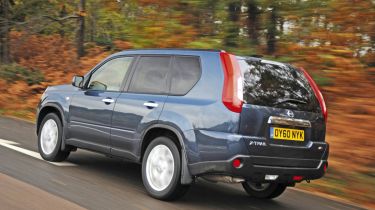Nissan X-Trail 2.0 dCi Tekna
Can a classy makeover take Nissan's compact off-roader to the top of the pile? We put it head-to-head against stylish Korean rival the Kia Sorento to find out.
Japanese giant Nissan knows a thing or two about off-roaders. As with the smaller Qashqai, the original X-Trail proved to be something of a hit for the firm – it was the third-best-selling 4x4 in Europe. The second generation arrived in 2007, but has now been revised, and the latest model promises to be the best yet.
Designers have left the compact SUV’s looks well alone, so the exterior changes are minimal. The most obvious revisions are to the grille, lights and bumpers. The tail-lamps now feature LEDs, the wheelarches have been widened and our Tekna model gets larger, 18-inch alloys. Compared to the bland Sorento, the Nissan stands out as the more distinctive design.
Despite its wider new look, it’s narrower than the Kia. Study the specs, and you’ll find it gives away 95mm to the Sorento – which makes it perfect for squeezing down lanes and tracks. On the outside, the Nissan has an elongated look, and from the driver’s seat you really notice how much closer you’re sitting to your passenger than you do in the Sorento.
There’s nothing wrong with the driving position, though. It’s much more car-like than its rival, and the huge range of steering wheel adjustment makes it easy to get comfortable. You benefit from lots of kit, too: Tekna trim includes heated leather seats, sat-nav, a colour reversing camera and cruise control all as standard. Much of the switchgear feels old-fashioned when compared to its Korean rival, though.
Used - available now

2020 BMW
4 Series
29,690 milesAutomaticPetrol3.0L
Cash £20,501
2023 Ford
Focus
21,621 milesManualPetrol1.0L
Cash £15,998
2023 Audi
e-tron
15,498 milesAutomaticElectric
Cash £23,158
2023 Audi
e-tron
29,621 milesAutomaticElectric
Cash £21,738Rear passengers will also note that there’s less room – you’ll struggle to fit three broad-shouldered adults comfortably across the back. And unlike the Kia, there’s no seven-seat option.
Open the boot, however, and there’s not much between our duo when it comes to space. In fact, the Nissan provides more ultimate load capacity with its seats folded, and there’s even a clever false floor, which is ideal for stowing muddy outdoor gear.
On paper, the X-Trail has strong performance credentials, but in reality it struggles to keep pace with the lively Sorento. While its 171bhp 2.0-litre diesel is relatively hushed and has a real appetite for the red line, if you let the revs drop too low, the engine bogs down, and you find yourself reaching for a lower ratio to get meaningful acceleration. Dropping down a gear helps, although the notchy shift action makes swapping cogs a chore rather than a pleasure.
The over-sensitive throttle doesn’t help, either, and in traffic makes for jerky progress. However, the Nissan’s biggest black mark was gained in our braking tests. In normal use, the anchors work perfectly well, but they took an age to bring the 4x4 to a halt in our emergency high- speed stop – it required 10 metres longer to come to halt than the Kia from 70mph, at 62.6 metres. There’s also far too much dive under hard braking, which doesn’t inspire confidence as the rear end moves around nervously behind you.
The X-Trail has always been a strong contender in this market, and it’s as economical, well equipped and practical as ever. The question is, will its dynamic weaknesses be shown up by the bigger Sorento?
Details
Chart position: 2
WHY: The updated X-Trail promises to be the best yet, with revised engines and improved equipment. It still looks distinctive, and a clever 4WD system ensures it’s more than capable off road.






